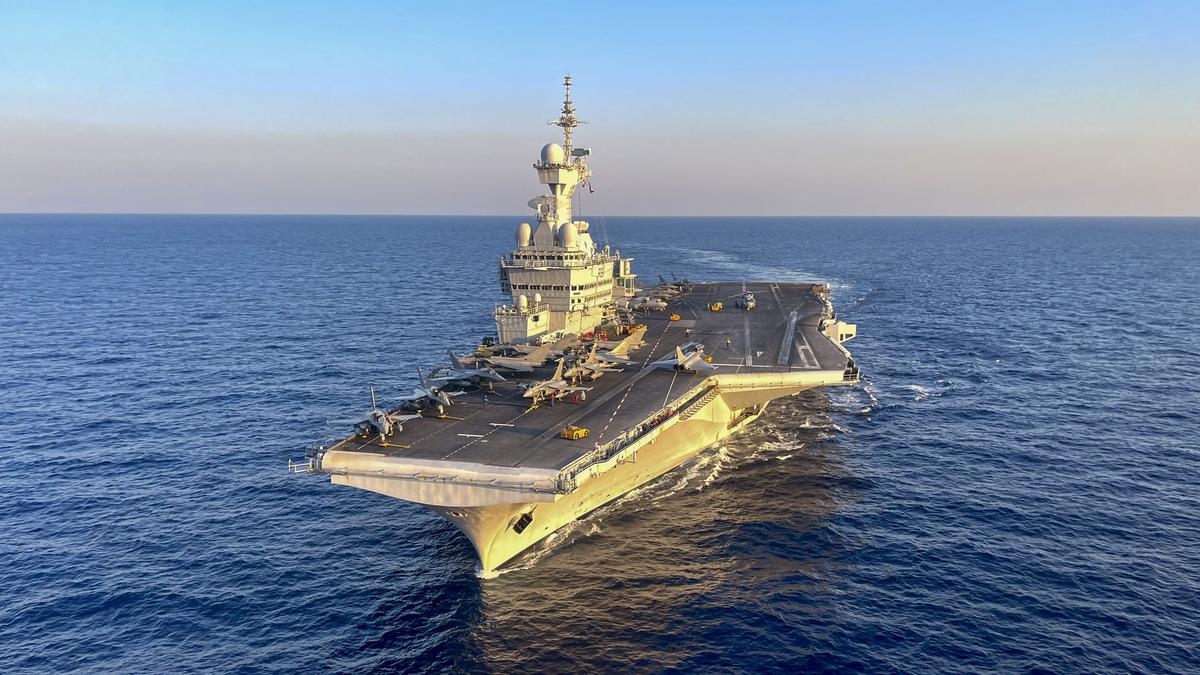Aircraft carriers are the “key” to win battles at sea, underscored Captain of the French aircraft carrier Charles de Gaulle, George Florentine.
Several nations in the Indo-Pacific have been fielding more and bigger carriers despite questions about their viability. The French Navy too is looking to induct a new carrier by 2038 while Indian Navy’s proposal for a second Indigenous Aircraft Carrier, a repeat of the Vikrant with some modifications, is currently awaiting approval of the Defence Acquisition Council.
“Many nations want a powerful Navy and they are building carriers. This is why a key concern has been the need to transfer the skills of operating a carrier from one generation to the next generation, so that the new generation can operate a bigger carrier with new technologies on board… and can win the battle at sea,” he said, while speaking to The Hindu on board the Charles de Gaulle during the bilateral naval Exercise Varuna held in the Arabian Sea off Goa from March 19 to 22.
On naval cooperation, Captain Florentine, who took part in the first edition of Varuna as a young officer, said things have changed since those times. “Nowadays, we have good camaraderie, we can exchange a lot of information and this is a beginning to be able to conduct operations. When you want to operate together at the sea, it is important to talk to each other,” he said, stressing on communications. “We need to have same procedures, which is not exactly the case with India but our procedures are close enough to be able to cooperate closely. What is important is that you have to know your counterparts. That is why we have commanding officers visit each other’s ships to build trust,” he stated.
The Charles de Gaulle also exercised with an U.S. carrier and Japan’s helicopter carrier.
A Rafale-M jet being secured on the lift on French carrier Charles de Gaulle off the coast of Goa, in the Arabian Sea.
| Photo Credit:
Dinakar Peri
As Exercise Varuna was under way, Rear Admiral Jacques Mallard, Chief of the French Carrier Strike Group, stressed that building partnerships in the Indo-Pacific reflects the interest in maintaining the status quo, showing that the “common space which is the high seas needs to be shared”.
“Anytime somebody just says that this is a common space, now it’s become mine. It is wrong. I think we all agree on that, and if everybody that agreed on that, show that working together make that stronger, I think it’s a good thing,” he said to a question from The Hindu onboard. Just before the conversation, he got back from a visit to INS Vikrant, where a debrief of the exercise was held as it just concluded.
A new wave of maritime activity, including military build-up, is under way in the Indo-Pacific region amid the rapid expansion of the Chinese Navy and its presence in the Indian Ocean Region. As per the U.S. Department of Defence, Chinese Navy is the world’s largest with over 370 platforms, including major surface combatants, submarines, ocean-going amphibious ships, mine warfare ships, aircraft carriers, and fleet auxiliaries.
The nuclear-powered Charles de Gaulle operates Rafale-M fighter jets, E-2 Hawkeye early warning aircraft and helicopters onboard. Joint operations with the Rafale-Ms were of particular interest to the Indian Navy as it is looking to induct them in the next few years. A deal for 26 Rafale-Ms is awaiting final approval from the Cabinet Committee on Security and expected to be signed this month.
On this, Rear Admiral Mallard said the Indian side had a lot of questions about the Rafales when they visited the ship and spoke to their French counterparts. He also noted that Indian Navy pilots already had good knowledge of the Rafales as the Indian Air Force operated the jets. “Most of the questions were concerning the handling (the jets) on board the aircraft carrier,” he stated, adding that they were shown the hanger, their handling on board the carrier, and how they are transported.
Captain Guillaume, Carrier Air Wing Commander onboard Charles de Gaulle, said the joint training during Exercise Varuna was “very profitable” and they their way of working was very close to the operations in India. On the operation of the air wing on the Charles de Gaulle, he added, “We have close to 100% availability of the jets everyday, we are able to have up to 40 to 50 flights every day from carrier to be able to perform all types of missions, from air defence, strike, anti-ship deterrence and so on.”
In January, navies of nine Indo-Pacific countries, including India, took part in the multilateral exercise La Perouse hosted by France and led by Charles de Gaulle which was held in the strategic straits between the Indian Ocean and the Pacific Ocean: Malacca, Sunda and Lombok. Indian Navy had deployed guided missile destroyer INS Mumbai for the exercise.
The PLA Navy currently operates two aircraft carriers, Liaoning and Shandong, both of which are conventionally powered and use a ski-jump ramps to launch aircraft. The third carrier Fujian, with a displacement of 80,000 tonnes and electromagnetic catapults to launch aircraft, has completed seven rounds of sea trials beginning May 2024 and is expected to be commissioned into service soon. A fourth carrier, bigger than Fujian, and likely to be nuclear powered, is under construction. In January, China unveiled the first Type 076 amphibious assault ship, displacing over 40,000 tonnes, which is equivalent to a medium-sized carrier, and capable of launching fighter jets.
Published – April 06, 2025 10:34 pm IST
